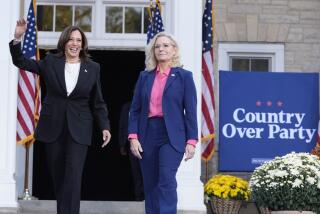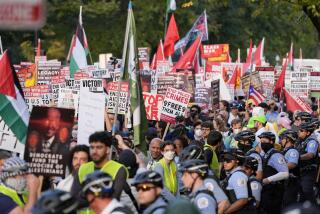Anti-Bush Protesters Fill N.Y. Streets
- Share via
NEW YORK — More than 100,000 demonstrators flooded the streets of Manhattan on Sunday in a strong show of opposition to President Bush and the war in Iraq as this city geared up for the Republican National Convention.
The loud, exuberant march, which at one point filled 40 blocks with people shouting slogans and waving signs, led protesters past Madison Square Garden, site of this week’s GOP gathering. Police -- who lined the streets in riot gear -- said the march was peaceful, but they did have scattered scuffles around the city with demonstrators, and arrested more than 200 people.
For the record:
12:00 a.m. Sept. 9, 2004 For The Record
Los Angeles Times Thursday September 09, 2004 Home Edition Main News Part A Page 2 National Desk 1 inches; 36 words Type of Material: Correction
Convention protest -- An Aug. 30 article in Section A about protests at the Republican National Convention in New York said that an antiwar group had carried more than 100 flag-draped coffins. Protesters carried 1,000 coffins.
As the protests took place, Vice President Dick Cheney arrived in New York and was honored at an Ellis Island rally, where he praised Bush’s leadership in the war on terrorism, calling him “exactly the leader we need for these difficult times.”
The president, who was campaigning in West Virginia, called the war a “catastrophic success.” He noted in a Time magazine interview in today’s editions that he still would have gone into Iraq, but with different tactics, had he known “that an enemy that should have surrendered or been done in escaped and lived to fight another day.”
In response, Democratic vice presidential candidate John Edwards said Sunday that Bush was only half right, suggesting “it was catastrophic to rush to war without a plan to win the peace.”
Bush’s conduct of the war drew angry protests during the march here, which lasted nearly six hours. Organizers, who had lost a lengthy court battle last week to hold a concluding rally in Central Park, called the march a success and estimated the size of the crowd at more than 500,000 people, far exceeding earlier predictions. Police estimated the crowd at 120,000 people.
Either way, the march was expected to be the largest such protest during the GOP gathering, and it drew an unusually big crowd for a U.S. political convention.
The participants, who hit the streets on a steamy afternoon, “were peaceful and they showed that thousands of people can turn out peacefully and make their voices heard,” said Bill Dobbs, spokesman for United for Peace and Justice, which organized the event.
The final route, which was agreed to in recent days, called for protesters to march north on Seventh Avenue from Union Square in Greenwich Village before passing Madison Square Garden and looping back on Fifth Avenue to the starting point. After the march ended, several thousand went to Central Park, where they chanted and held signs but did not hold a rally with microphones or a stage.
The arrests included several dozen from a group called Queer Fist, who police said tried to disrupt traffic in the theater district on a night when many GOP delegates were heading to Broadway shows.
The group had marched from the New York Public Library to the theater district, intending to confront Republican delegates, according to the National Lawyers Guild. The guild is monitoring police activities during the convention protests.
New York Police Commissioner Raymond W. Kelly told reporters that the protesters laid down and blocked the street. The guild lawyers said police ordered the protesters to disperse, then arrested them before they were able to leave.
Officers also reported arresting about 40 bicyclists who tried to join the march up Seventh Avenue, and others who had set fire to a papier mache dragon as they paraded past Madison Square Garden. Three officers were injured during tussles with demonstrators, who were taken away in buses and vans.
Police noted, however, that most marchers were peaceful. They came from across the nation, representing a variety of causes and political organizations. A mixture of young activists and older veterans of political marches from the 1960s, they were united in the belief that Bush must be defeated.
“We know that American protesters who marched in the street helped end the Vietnam War, and they also played a role in ending apartheid in South Africa,” said George Martin, a veteran activist from Milwaukee. “That’s what we’re trying to say with today’s march, that you can still change the world. You must never stop trying.”
The march began just before noon, with demonstrators blowing whistles, pounding drums and shouting antiwar slogans. As they moved up Seventh Avenue, they were cheered by large numbers of people watching from apartments and offices lining the street. Large signs reading “Defeat Bush Now” were draped from high-rise buildings.
Although the parade route resembled an armed camp, with helicopters buzzing overhead and squads of police stationed on every block, the march had a festive, party-like mood.
“I still believe in an America where we don’t engage in illegal wars,” said Debby Churchman, a writer and teacher from Arlington, Va. “We don’t have to kill innocent people to make this country safe. What we need is new presidential leadership.”
When the demonstrators reached Madison Square Garden -- where a large neon sign welcomed the Republicans to New York -- many began hooting and blowing whistles, shouting curses about the Bush administration. An antiwar group carrying more than 100 flag-draped coffins began shouting “Bush must go” as they passed.
The marchers were met with spirited, if limited, opposition. A large group confronted people on the sidewalks holding pro-Bush signs, for example, and heated exchanges took place. Ruben Israel, who was holding a sign that read: “Support President Bush -- Trust Jesus,” at one point was surrounded by angry marchers at the corner of Seventh Avenue and 34th Street.
“The Big Apple is rotten, and all of you are lunatics,” said the Los Angeles man, who described himself as a “right-wing conservative Christian.” He began shouting “Trust Jesus!” to marchers, who responded with the chant: “Who would Jesus bomb?”
Farther up the march route, near Macy’s in Herald Square, a woman held a sign reading “Kerry is Unfit” -- referring to Democratic presidential nominee Sen. John F. Kerry; she was engulfed by marchers shouting “Shame!”
“I’m angry at the animosity shown at this march toward the president,” said Kathryn Wells of St. Augustine, Fla. “He’s more qualified than Kerry.”
Five miles south of the march, Republicans kicked off their convention week with a rally celebrating Cheney’s arrival. He embraced the symbolism of the Sept. 11 attacks as he stood on Ellis Island and pointed to the post-2001 view of Lower Manhattan behind him, arguing that Bush had responded with strength after the attacks.
“The sure reminder of that is the skyline of this great city, which was altered so violently on Sept. 11, 2001,” Cheney said.
“There are those in this world who have set themselves against the freedoms which we enjoy, fanatics who hate the idea of equality, who want everyone to live the way they do and who are willing to murder innocents to accomplish their goals,” the vice president said. “They have attacked our nation and they wish to do us further harm. It is for them, from them, that we must protect our children, our country and our future.”
Cheney and his wife, Lynne, arrived on a tugboat, the Liberty IV, joined by former New York Mayor Rudolph W. Giuliani and New York Gov. George E. Pataki, to address the sparsely attended rally.
Sunday’s event underscored the GOP’s intention of using its New York convention, coming just days before the third anniversary of the terrorist attacks, as a reminder of the president’s response to the crisis. Some analysts have said the Republicans would tread carefully around the attacks, walking a fine line of promoting Bush’s leadership while not appearing to politicize them.
The president spent a portion of the day campaigning in West Virginia, where he was hailed by a local union leader as “the man who saved steel.” Bush got a thunderous welcome from 10,000 residents in Wheeling, basking in their support for the tariffs on foreign steel that he imposed two years ago to help the U.S. steel industry.
“I saw a need to stand up for steel, and I did stand up for steel,” Bush said at a campaign rally in the packed WesBanco Arena. “When it comes to a strong and vibrant steel industry, we’re getting the job done,” he said.
When Bush imposed tariffs on imported steel, he touched off a political firestorm. Steelworkers hailed the move, but foreign steel companies howled in protest, as did domestic consumers of steel, such as the auto industry, which suddenly faced higher prices. A similar controversy erupted when Bush ended the tariffs 21 months later in December 2003.
All the while, the president’s political detractors portrayed his moves as those of a man who did not stand by his stated principle of supporting free trade.
Phil Singer, a spokesman for the Kerry campaign, said Sunday that the Massachusetts senator had backed the tariffs but believes that Bush ended them prematurely, leaving the industry insufficient time to restructure.
Kerry’s campaign also issued a statement accusing Bush of failing to promote clean coal technology and mine safety.
In his remarks, the president said he remained a fervent supporter of free trade, as long as trade is conducted on an even playing field. He said the steel tariffs had helped the domestic industry reposition itself to compete in the world.
Gesturing to an array of steelworkers standing behind him, Bush said: “If we think an industry is being treated unfairly, we’ll enforce the law. And that’s exactly what I did. The plan worked,” he said. “These folks back there are working.”
Times staff writers Aaron Zitner and Peter Wallsten in New York and Edwin Chen in Wheeling contributed to this report.
More to Read
Get the L.A. Times Politics newsletter
Deeply reported insights into legislation, politics and policy from Sacramento, Washington and beyond. In your inbox three times per week.
You may occasionally receive promotional content from the Los Angeles Times.











